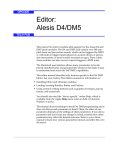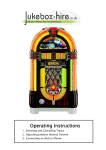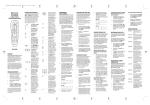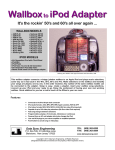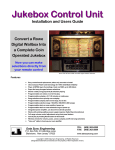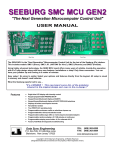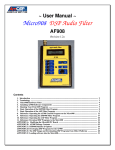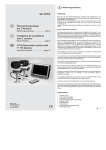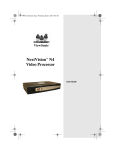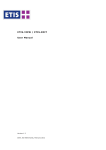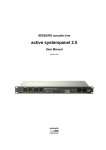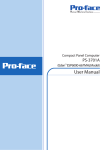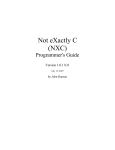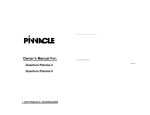Download SCD-MP3 - CD Changer Interfaces and Conversion Kits for
Transcript
SCD-MP3 HDD or CF MP3 Player For Your Seeburg SCD Jukebox • • • • • Works with all notebook HDD’s or CF Supports all layer-III (MP3) encodings Variable or fixed bit rates to 320 Kbps Detects master/slave drive setting Automatic power down on no activity The SCD-MP3 is a micro-computer based hard disk player that replaces the 60-disc CD player in your Seeburg model SCD-1x jukebox. The hard disk player works with any jukebox that uses the Sony model CDK-006 changer. The SCD-MP3 plugs directly into the Control Computer. A new “turbo” EPROM chip replaces the old program on the PCM computer board. The player takes only minutes to install, without any modifications to the jukebox. Best of all, the player will not skip and will never need to be cleaned or lubricated. The new “turbo” program provides super fast plays between song selections and does not require learn-in. Other features include 60 or 90 CD selections with each having up to 99 tracks plus random background and stimulation plays. The player works with any PATA 44-pin ATA/IDE 2.5 inch notebook HDD or Compact Flash memory card formatted as FAT32. 16 to 20GB should provide enough storage space for your 60 CD jukebox. DISCLAIMER – PLEASE READ The SCD-MP3 kit was developed for jukebox owners for non public performance use. We do not supply jukebox licenses and do not have any knowledge of what is required. It is the jukebox owners responsibility to obtain all applicable licenses for public performance of copyright music. Data Sync Engineering P.O. Box 539, Footbridge Lane, Bldg 3 Blairstown, New Jersey 07825 TEL: (908) 362-6299 FAX: (908) 362-5889 Email: [email protected] Web: www.datasynceng.com Copyright © 2003 Data Sync Engineering. All Rights Reserved. Designated trademarks and brands are the property of their respective owners. Assembling the Hard Disk Drive or Compact Flash Memory Card This is the MP3 digital subsystem player circuit board with a hard disk drive attached. The Hard Drive is not included ! This is the Compact Flash Memory card version. It requires the "IDE to CF" adapter board which plugs into the 44-pin IDE connector. The "IDE to CF" adapter board is available as a separate item. The Hard Drive or Compact Flash Memory cards are also available. The MP3-DSP music player system The hard disk drive has two sets of connector pins. 43-pins on the left side and 4-pins on the right. Position the disk drive onto the circuit board then align the left side pins with the 44-pin IDE connector. Slide the disk drive forward into the connector. The 4-pins on the right are not used. Arrow Faces Up Mount-down holes at each corner Rubber Feet Mounting Screws Permanent mount or removable Connecting IDE 2.5" Hard Drives Using the USB 2.0 External HDD Cable Laptop NoteBook 2.5" Hard Drive The 2.5" IDE Drive has one connector on the rear. This 44 pin connector is IDE DATA and IDE Power combined. This connector has a blocked socket and must be installed in the correct orientation. Match the blocked socket with the missing pin on the drive mechanism. 2.5" IDE Mechanisms get their power from the USB port. Optional Compact Flash Card Adapter CF Size 2GB 4GB 8GB 16GB 32GB 64GB @128 Kbps 500 1,000 2,000 4,000 8,000 16,000 @192 Kbps 400 800 1,600 3,200 6,400 12,800 CF Memory Inserted here Approximate song capacities: Connector 44-Pin IDE The 44-pin IDE adapter allows Compact Flash memory card usage. Works with FAT32 formatted cards 2GB and higher. Insert the memory card into the adapter then plug the adapter into the 44-pin IDE connector. Creating New Folders for Disc Numbers Connect your disk drive to the HDD USB cable. Open Windows Explorer Plug in the HDD USB cable into your computer. Within a few moments, a new disk drive letter should appear. For this example we see “Removable Disk F:” If you did not see a new disk drive letter, follow the instructions in your USB manual about setting up your new disk drive or you can visit www.cdadapter.com and go to the FAQ section. To create a new folder … Single click the new drive letter to hi-lite, Click File | New Then click on Folder You should see a New Folder name. Change the name … The first two letters must be your disc number from 01 to 06. The following letters can be any text you choose. Drag & Drop Your MP3 Song Files Select the disk and directory for your source of MP3 song files then click the + at “Removable Disk (F:)” to expand the folders. If you wish to copy the entire set of songs, click on the first song at the top, scroll down to the last song, hold down the SHIFT key then click the last song. The entire list should be hi-lighted. Move your mouse over the list then hold down the left mouse button and drag the list to your F: drive folder “The Beatles”. If you wish to move a single song, place your mouse over the song then hold down the left mouse button and drag it to your F: drive folder. Previously, folders were numbered to identify disc positions, here, MP3 song names must be numbered to identify their track position. Most MP3 “rippers” or “extractors” will provide this track numbering feature for you. If you need to change or add the track position number of a song, place the mouse over the song then right click and select Rename. Position your mouse to the start of the song name then left click. You should see a blinking cursor waiting for you to edit. Power Supply Audio Cable to Amplifier (Unplugged from Sony CD) Data Cable from PCM (Unplugged from Sony CD) Wireless Remote Sensor ly pp u S er w Po Installation Diagram t ec n n Co Arrow Faces Up The MP3-DSP Player Contr ol Cab le Con nect THE NEW TURBO EPROM PROGRAM FOR SEEBURG SCD-1x CD JUKEBOXES The Compact Disc was launched on the consumer market in October 1982 from the combined efforts of Philips (Netherlands) and Sony (Japan). By 1985, CD sales were skyrocketing. A year later, Seeburg introduced it‘s first CD jukebox called the Laser Music model SCD-1. Thousands of these jukeboxes were manufactured up until the model SCD1F (Skyline) in 1990. The sound system in this jukebox is superb. Instead of transistors, Seeburg used the latest MOSFET technology in it’s power amplifier design. Many say it resembles the performance of tube amplifiers. The six speaker system is also unique. It employs two 2x6 horn tweeters, two 5x7 polycone midrange and two powerful 12” bass reflex woofers. The CD player is the Sony 60 disc model CDK -006 which has a laser life of about 50,000 hours. Estimated life of this player should be around 20 years (to about 2006). Unfortunately, there are no player replacements which leaves some of these magnificent machines dormant. This has captured my interest to develop the Seeburg SCD-1x EPROM program called “turbo”. This new program has some of the improved SCD features plus an increase to 90 CD’s, but was mainly written to offer better and safer setup of the coin/ bill credit system, a much faster song play response and to work with either the PCM-1000 or PCM-2x00 phono control module. This, together with a new MP3 player system, adds a whole new life to the Seeburg SCD Jukebox. • • • • • • • • No modifications to the jukebox Takes only minutes to install Works with PCM-1000 or PCM-2x00 control computers No Learn-In is required Uses the high speed HDD MP3-DSP Player Super fast response between songs Can be set for 60 or 90 CD disc selections Switch selectable coin/dollar credits/bonus or Free Play • • • • • • • • Album plays from ENTER key or 00 track # Wireless remote for volume, pause, reject and BGM Background Music on/off from remote or keypad Play Stimulator at 15, 30, 45 or 60 minutes Viewable tracks per disc verification Viewable dip-switch settings verification “Battery low” and “EPROM checksum” messages Non destructible Total Lifetime Money & Play counters PCM-1000 Phono Control Module NOTICE: The PCM-2x00 Control Module does not have a dipswitch “A” component. In this case, a Virtual Dipswitch “A” memory location is used instead. See next page for the VDA one time setup. Carefully remove the EPROM from the socket by gently prying at each end using a small screwdriver. Insert the new EPROM with the notch facing up. TURBO Program “Switch Settings” NOTICE ! Before changing the dip-switch settings, record the current settings in case you decide to switch back Dip-Switch “A” - Monetary settings Dip-Switch “C” - BGM, Free Play & Stim. Example ratio setting: 3, 7, 10, 13 and 18 (at $1 increments) OFF —— Play Stimulator Interval Credit to Add 1, 2, 3 or 4 (see chart below) —— —— ON —— Play Stim. Disabled Keypad BGM On/Off OFF Free Play Play Stim. Enabled OFF OFF —— 8 ON (see chart below) OFF 7 —— Pay For Play BGM Range 61-90 6 OFF Credit to Add 1, 2, 3 or 4 OFF 5 —— No Keypad BGM (see chart below) BGM Reject On 4 OFF BGM Range, all OFF 3 —— —— 8 ($2 or $1) —— OFF 7 Credit at 8 Units —— Credit to Add 1, 2, 3 or 4 BGM Reject Off BGM Enabled OFF 2 ($1.50 or 75¢) —— BGM Disabled 1 —— —— ON Credit at 6 Units ($1 or 50¢) ON (see chart below) 6 —— Credit to Add 1, 2, 3 or 4 —— 5 Credit at 4 Units OFF —— 4 —— 3 (50¢ or 25¢) OFF 2 —— 1 Credit at 2 Units OFF —— 15, 30, 45 or 60 minutes (see chart below) Set switches D1 & D2 off. Set dipswitch “B” equal to the dipswitch “A” monetary settings, power up jukebox. After PLAY message, reset dipswitch “B” as credit options and switches D1 & D2 for jukebox model, press PCM RESET button. Setting the Virtual Dipswitch “A” for PCM-2x00. Dip-Switch “B” - Credit Options Dip-Switch “D” - Jukebox Options NOTE: All switches on select Factory Test Mode 1 2 3 4 Play Stimulator 15 Min 30 Min 45 Min 60 Min Consecutive Tracks Unlimited 1 per disc 2 per disc 3 per disc ON Credit at # Units Allow Album Play ON Album on 00 track ON Keep Selections —— OFF ON 8 B.A. = 4 Pulses / $ ON 7 Number of —— Consecutive Tracks/disc —— Keep Credits Disc Range 1-90 6 Erase Selections —— See Jukebox Model Setup For Details 5 Album on Enter key OFF —— 4 (see chart below) No Album Play 1 Pulse = 2 Units ON OFF Disc Range 1-60 Bonus Credit 0, 1, 2, 3 4, 5, 6, or allow Album OFF 3 —— —— OFF 2 8 B.A. = 1 Pulse / $ OFF 7 Erase Credits OFF Add 1 Credit at $2 —— —— Jukebox Model Type 1 1 Pulse = 1 Unit ON —— ON 6 —— Add 1 Credit at $1 —— OFF 5 After 20 Pulses Received ON 4 —— 3 $5 Bonus OFF 2 No $2 Bonus 1 No $1 Bonus —— Unlimited, 1, 2, or 3 (see chart below) Dip-Switch Chart OFF ON OFF ON OFF ON OFF ON OFF ON OFF ON OFF OFF ON ON OFF OFF ON ON OFF ON OFF OFF OFF OFF ON ON ON ON $5 Bonus No Credits 1 Credit 2 Credits 3 Credits 4 Credits 5 Credits 6 Credits ALBUM Dip Switch Features The PCM-1000 board uses both the keypad module (KM-1000) and service panel module (SPM-1000). The settings of Dipswitch “B” are copied to a memory location named “VDA”. The settings of Dipswitch “A” are used by the program. The PCM-2x00 board uses the keypad module (KM-1000) only. Dipswitch “A” is ignored because it is not inserted on the circuit board, used instead, are the copied settings in memory location named “VDA”. UNIT CREDITS Units are used as the method of evaluation for entered coins and bills. At 25 cents per play (switch B6 on), 1 pulse from the coin or bill acceptor will equal 2 units. This is to say that 1 quarter would need to be entered to reach the first credit step of Credit at 2 Units. The bill acceptor will produce 4 pulses per dollar giving 8 units to reach the forth credit step of Credit at 8 Units. At 50 cents per play (switch B6 off), 1 pulse from the coin or bill acceptor will equal 1 unit. This is to say that 2 quarters would need to be entered to reach the first credit step of Credit at 2 Units. The bill acceptor will produce 4 pulses per dollar giving 4 units to reach the second credit step of Credit at 4 Units. It would take $2 worth of coins or bills to reach the forth credit step of Credit at 8 Units. After the Credit at 8 Unit step is reached, the unit counter is cleared and the credit steps are again repeated. The pulse counter is not affected. After a song selection is made, both the unit counter and pulse counter are cleared. BONUS CREDITS After unit credits are processed, bonus credits can be added. Bonus credits are based on the accumulative pulse counts from the coin or bill acceptor. At 4 pulses ($1), switch B1 allows an extra bonus credit to be added. At 8 pulses ($2), switch B2 allows an extra credit to be added. And finally at 20 pulses ($5), different bonus credits or album selection can be added by switches B3, B4 & B5. ERASE CREDITS / KEEP CREDITS Unused credits remaining on the jukebox when powered-off can either be saved (switch B7 on) or erased (switch B7 off). BILL ACCEPTOR SETTING: 1 PULSE PER DOLLAR BILL / 4 PULSES PER DOLLAR BILL Switch B8 is off if Bill Acceptor outputs 1 pulse per dollar bill, switch B8 is on if Bill Acceptor outputs 4 pulses per dollar bill. BGM DISABLED / BGM ENABLED When switch C1 is on, background music from the MP3 player can be toggled on/off from the wireless or wired remote. If switch C4 is also on, background music can be toggled on/off from the keypad by entering “0000”. A random disc/track background music play will immediately follow the end of the last selected play when no other selections are waiting to be played. This provides non-stop music plays. The BGM and AUX volume control levels can be adjusted on jukeboxes that use the PAM-2000 power amplifier module. The amplifier AUX input is automatically selected when BGM is off and no song selections are being played. BGM REJECT OFF / BGM REJECT ON If switch C2 is on, the selected song has priority over background plays. The background song will be rejected. BGM RANGE ALL DISCS / BGM RANGE 61-90 If switch C3 is off, random background selections will be played from discs (1-60 if D2 is off) or (1-90 if D2 is on). If switch C3 is on, random background selections will be from discs 61-90 only. NO KEYPAD BGM / KEYPAD BGM ON-OFF If both switches C1 & C4 are on, background music can be toggled on/off from either the wireless or wired remote or from the keypad by entering “0000”. NOTE: Background toggle from keypad requires at least 1 credit or Free Play to operate. PAY FOR PLAY / FREE PLAY When switch C5 is on, the display will show FP in the credit digits and allow unlimited selections. PLAY STIMULATOR FEATURE DISABLED / PLAY STIMULATOR FEATURE ENABLED If switch C6 is on, the jukebox will select a random disc/track when “no activity” for the time as set by switches C7 & C8. PLAY STIMULATOR INTERVAL Switches C7 & C8 set the time period of random plays when there is no jukebox activity. Time period of every 15-min, 30min, 45-min or 60-min can be chosen. DISC RANGE 1-60 / DISC RANGE 1-90 If D3 is off, disc selection range is 1-60, if switch D3 in on, selection range is 1-90. If the selected disc or track is not found, the “Error “ message will be displayed. (D4) NO ALBUM PLAY / ALLOW ALBUM PLAY and (D5) ALBUM ON ENTER KEY / ALBUM ON “00” TRACK [ ] Allow ALBUM selection after 2-digit disc number then ENTER key Switch “D4” on and switch “D5” off [ ] Ignore the ENTER key and allow ALBUM selection on “00” track number Switch “D4” on and switch “D5” on [ ] Ignore the ENTER key and allow ALBUM selections only after $5 worth of credits entered Switch “D4” off, switch “D5” on and switches “B3”, “B4” & “B5” on [ ] Ignore the ENTER key and NO ALBUM selections Switch “D4” off and switch “D5” on ERASE SELECTIONS / KEEP SELECTIONS Any un-played selections remaining in memory when the jukebox is powered-off can either be saved (switch D6 on) or erased (switch D6 off) when the jukebox power is turned back on. NUMBER OF CONSECUTIVE TRACKS PER DISC If switches D7 & D8 are both off, all songs are played in the order as entered, including track after track album plays. Otherwise, these switches can set the number of track plays allowed on the same disc when more than 1 disc number is waiting to be played. For example, if the consecutive track count was set to 2 and the user made 3 disc album selections with the 1st album having 10 tracks, the 2nd having 12 tracks and the 3rd having 14, the first 2 albums would cycle back and forth playing 2 songs on each until all songs were played on album 1 which would then cause the 2 song cycle between album 2 & 3, then finally, the balance of all songs on album 3 would be played. This also applies to multiple mixed tracks on the same disc. “KWIK PICK” SELECTIONS ON JUKEBOX MODELS SCD-1C, SCD-1D & SCD-1F The “Kwik Pick” lamp will not illuminate until after 10 or more popular hits have accumulated and the jukebox has credits or is in free play. This only occurs after the TOP 40 has been cleared. Afterwards, the TOP 40 popular hits are updated as jukebox selections are made. A popular hit is defined as a song that has been played 2 or more times. As new popular hits, or the same hits are selected, they are placed at the top of the list, and eventually, the older popular hits will drop off. “TOP 40” LAMP ON JUKEBOX MODELS SCD-1C, SCD-1D & SCD-1F The “TOP 40” lamp will illuminate when the playing song is found in the popular hits list. The selection keypad can be alternately switched between selection mode and service mode by pressing the SERVICE button. When pressed, the message “SCE on” will momentarily appear to indicate the keypad is for service functions, press it again and the message “SCEoFF” will momentarily appear when in selection mode. Selection mode is entered when the jukebox is powered-up or the PCM RESET button is pressed. Entering SERVICE MODE clears the “Check Battery” LED and “bAt Lo” display message No FREE CREDITS function during PLAYER TEST function. KEYPAD TEST can only be exited by pressing the PCM RESET button or power-off the jukebox. Jukebox Model Setup 1 2 3 PLAYER TEST DIPSWITCH SETTINGS DISC TOC CHECK Dipswitch “D” DISPLAY TEST AUDIT POPULARITY 7 8 9 CLEAR FREE CREDITS REVERSE Control Computer: PCM-1000 With Audio Power Meter ON RESET ON REJECT 2 KEYPAD TEST SCD-1 Dipswitch “D” 1 ENTER 0 OFF ON 6 2 5 1 4 OFF SCD-1A, SCD-1B Control Computer: PCM-2000 OFF SERVICE EXIT Service Mode switch functions are shown in small print 4 PLAYER TEST DIPSWITCH SETTINGS DISC TOC CHECK DISPLAY TEST 5 6 7 8 AUDIT POPULARITY CLEAR FREE CREDITS RESET 9 0 SERVICE EXIT REVERSE REJECT KEYPAD TEST 0 1 2 3 REJECT PLAYER TEST DIPSWITCH SETTINGS DISC TOC CHECK RESET 4 5 6 SERVICE EXIT DISPLAY TEST AUDIT POPULARITY ALBUM 7 8 9 CLEAR FREE CREDITS REVERSE OFF ON SCCD-1 Classic Control Computer: PCM-2x00 1015 Bubbler Repro ENTER Dipswitch “D” ON 2 ON ON 1 KEYPAD TEST Dipswitch “D” ON 3 2 2 1 1 SCD-1C, SCD-1D, SCD-1F Control Computer: PCM-2100 With 40-Hit Kwik Pick (1) PLAYER TEST The jukebox will play all the tracks on disc 1, then all the tracks on disc 2, etc., until all tracks on all discs have been played. During play, the display will show Disc, Track, t2. The cycle will continue to repeat until this service function is exited. Pressing the CLEAR button (7) will erase stored credits & selections. (2) VIEW DIP-SWITCHES Shows the on/off position of each dip-switch setting using the display segments. Each button press cycles through dip-switches A, b, C, and d then back to A. If PCM-1000 board, the actual dip-switch A is displayed. If PCM2x00 board, the memory location named VDA (Virtual Dip-switch A) is displayed instead. 4 5 6 OFF ON 3 OFF 2 OFF OFF 1 OFF OFF ON ON 7 8 (3) DISC TOC CHECK When first entered, the total number of discs initialized (learned-in) will be displayed then each button pre ss steps through each disc number showing the number of tracks found. The REVERSE button (9) can be used to change the step direction. Zero track count indicates “no disc”. Also from TEST on the SPM-1000 service keypad Disc Number (4) Number of Tracks DISPLAY TEST All six display digits will cycle together showing numericals 0 – 9 at a rate of three per se cond. First all digits will show 0’s then all 1’s etc., through the 9’s and repeat. All LED’s and selection lamps will also flash on & off at 11/2 times per second. The cycle will continue until this service function is exited. Also from AUDIT on the SPM-1000 service keypad (5) AUDIT There are 7 audit functions plus clear. Each button press steps to the next audit function. The last function, AdtCLr, allows the audit data to be erased by pressing the CLEAR button (7). The total lifetime money audit is an accumulative count for this jukebox and will not be erased. 1 C00000 Total number of coins 5 PL0000 Total # of selections played 2 bL0000 Total number of bills (x4) 6 AL0000 Total # of album selections 3 000000 Total lifetime money 7 Crd000 Number of free credits 4 SL0000 Total # of selections made 8 AdtCLr Push CLEAR to erase audits Also from POP on the SPM-1000 service keypad (6) POPULARITY Each button press steps through disc popularity rankings from least to most popular. The step direction can be changed by the REVERSE button (9). The last function, POPCLr, allows the popularity and Top 40 lists to be erased using the CLEAR button (7). The total lifetime plays will not be erased. Also from CLEAR on the SPM-1000 service keypad (7) 000000 Total lifetime plays dPxxyy “xx” is disc #, “yy” is rank # Most popular rank is 01 Least popular rank is 60 (—) if disc has never played POPCLr Push CLEAR to erase all popularity rankings and Top 40 list. CLEAR (8) FREE CREDITS This function is used to add credits. Each button press adds 1 credit up to a maximum of 99 credits. This function is ignored during Player Test. Also from REVERSE on the SPM-1000 service keypad (9) SWA Also from CREDIT on the SPM-1000 service keypad Record Your Original Switch Settings Here ON 1 2 3 4 5 6 7 8 Not available on PCM-2x00 control modules SWB This function erases the accumulated counts of money, selections and popularity. To clear audits, press (5) until “AdtCLr” appears then press (7). For popularity, press (6) until “POPCLr” appears then press (7). You can also clear stored selections and credits, press (1), when Player Test starts, press (7). ON 1 REVERSE 2 3 4 5 6 7 8 2 3 4 5 6 7 8 2 3 4 5 6 7 8 NOTE: to set MP3-DSP player back to normal volume level (in case remote was lost) press (1), when Player Test starts, pre ss (9). ON 1 (0) REJECT This button is not the same as the REJECT at the back of the cabinet. This button causes a player stop which simulates reaching the end of the current playing track. SWD Also from REJECT on the SPM-1000 service keypad SWC This function switches the direction of the popularity or disc toc steps while in that function. ON 1 Wireless Remote Control (ENTER) or (ALBUM) KEYPAD TEST This function displays the name of each keypad button press. On PCM -2x00 equipped jukeboxes, it will also display the coin, bill acceptor and “Kwik Pick” switches. Once the keypad test is entered, the only way to exit is by pressing the reset on the PCM board or power off the jukebox. Also from RESET on the SPM-1000 service keypad Mute Toggles pause on/off VOLDecreases the volume level Remote Set Up (RESET) SOFT RESET Remote sensor “eye” can be placed at the corner edge inside title page glass, in speaker grill or front panel. This function performs a jukebox “soft reset”. In other words, as long as the program is operating (not crashed), this function will be re cognized. A “hard reset” can be done by pressing the RESET button on the PCM board or power off the jukebox. POWER Cancels song play CHAN+ Toggles BGM on/off (needs switch C1 on) VOL+ Increases the volume level Press & hold POWER and Mute buttons simultaneously until LED flashes on/off then remains on. Release buttons Press VOLOnce Press CHAN+ 2-Times Press Mute to save, LED should turn off, error if blinking. Power-Up Displays This message is momentarily displayed when the jukebox is powered-up or the RESET button is pressed. If the first two letters are “JP”, check the 37-pin cable connections. If only “J” instead of “JP” is displayed, you may have a problem with the jukebox memory chip or PCM board. This rotating pattern indicates that the jukebox is waiting for the player to be ready. Normally it appears for a few seconds (depending on the number of songs). If it appears longer than a minute, a player problem may exist or the Interface Control Unit may not be plugged in. If at any time the jukebox memory becomes corrupted, such as from a low battery or severe electrical storm, this message will appear each time the jukebox is turned on. It is cleared by entering the SERVICE mode. NOTE: this indicates popularity and audit data was erased. This is the final display message which shows a four character checksum calculation of the EPROM program. Each new version of an EPROM program will display different checksum numbers and letters. Refer to this checksum code when reporting errors and problems.














